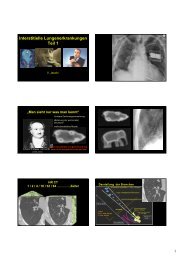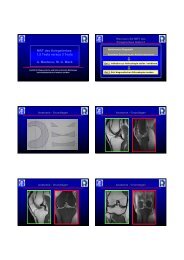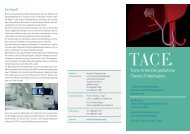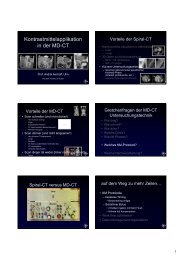Laser-induced Interstitial Thermotherapy University Hospital Johann ...
Laser-induced Interstitial Thermotherapy University Hospital Johann ...
Laser-induced Interstitial Thermotherapy University Hospital Johann ...
You also want an ePaper? Increase the reach of your titles
YUMPU automatically turns print PDFs into web optimized ePapers that Google loves.
Minimal invasive destruction of tumors<br />
by<br />
<strong>Laser</strong> <strong>Interstitial</strong> ThermoTherapy (LITT)<br />
Advantages<br />
• Out-patient therapy management<br />
• Repeatability of treatment<br />
• Treatment under local anesthesia<br />
• All metastases can be reached<br />
• MRI-guided procedure for exact installation of<br />
therapy<br />
procedure<br />
For<br />
further<br />
information<br />
contact<br />
Contact<br />
Institut für Diagnostische und<br />
Interventionelle Radiologie<br />
Interventions-Ambulanz<br />
Theodor-Stern Kai 7<br />
60590 Frankfurt<br />
Tel: 069-6301-4736<br />
Fax: 069-6301-7288<br />
Prof. Dr. Martin G. Mack<br />
email: martinmack@arcor.de<br />
Prof. Dr. Thomas J. Vogl<br />
email: T.Vogl@em.uni-frankfurt.de<br />
Secretary Tel: (49) 69-6301-7277<br />
Fax: (49) 69-6301-7258<br />
Internet http://www.litt-therapie.de<br />
Development of LITT<br />
The present form of laser therapy has been developed by<br />
Prof. Vogl and Prof. Dr. Mack in close co-operation with Dr.<br />
Roggan from <strong>Laser</strong> and Medicine Technology GmbH<br />
(LMTB), Berlin, Germany. The procedure is continuously<br />
optimised and used routinely in clinical practice with great<br />
success.<br />
1982 <strong>Laser</strong> coagulation was reported for the first<br />
time using the so-called bare fibre with only<br />
small necrosis.<br />
1992 Experimental investigation of LITT with<br />
catheter and diffuse laser applicators.<br />
1993 Treatment of the 1st patient with LITT<br />
10/1996 100 patients treated<br />
12/1999 500 patients treated<br />
09/2007 2,000 patients treated with 5,100 metastases.<br />
© 2007 Vogl/Mack Institute for Diagnostic and Interventional<br />
Radiology<br />
LITT<br />
<strong>Laser</strong>-<strong>induced</strong> <strong>Interstitial</strong><br />
<strong>Thermotherapy</strong><br />
<strong>University</strong> <strong>Hospital</strong><br />
<strong>Johann</strong> Wolfgang Goethe <strong>University</strong><br />
Frankfurt am Main<br />
Institute for<br />
Diagnostic and Interventional<br />
Radiology<br />
Director: Prof. Dr. Thomas J. Vogl
Information about LITT<br />
The use of local thermal effect in the tumor<br />
region forms the basis for this new minimal-<br />
invasive therapeutic procedure. Since the<br />
development of MRI-guided laser-<strong>induced</strong><br />
<strong>Interstitial</strong> ThermoTherapy (LITT), it is possible<br />
to target the laser exactly on the tissue volume<br />
to be treated. Due to comparably high<br />
penetrability of photons and the possibility of<br />
complication-free transfer of energy through<br />
guide-light, <strong>Laser</strong> of Near Infrared Region (NIR)<br />
is used for LITT. Above all we use the Nd:YAG-<br />
<strong>Laser</strong> (1,064 nm), which has a wide clinical use.<br />
The energy is applied to the target tissue using<br />
special laser applicators. The energy of laser<br />
light is absorbed, which causes heating of the<br />
tissue. The heat causes<br />
coagulation (destruction)<br />
of tumor tissue and the<br />
edge around it. In order<br />
to make the advantages<br />
of the effect and<br />
accuracy of the therapy<br />
useful, all the factors contributing to the success<br />
of therapy must co-ordinate with one another.<br />
For this, it is necessary to calculate the exact<br />
duration and output of the laser. Therefore under<br />
certain circumstances more laser applicators<br />
and more cycles of therapy, may be required<br />
depending on size, number and location of the<br />
lesion to be treated. These parameters are<br />
adapted individually according to the illness. In<br />
practise a temperature of about 60 to 110° C is<br />
achieved in the tumor tissue. This differentiates<br />
LITT from the classical hyperthermia.<br />
It is scientifically proven that local resection or<br />
destruction of liver metastases prolongs the life<br />
of patients and chemotherapy is then to be<br />
preferred.<br />
Metastasis in segment 8, native<br />
MRI before LITT<br />
Metastasis in segment 8, native<br />
MRI after LITT. The metastasis<br />
and the edge around is fully<br />
coagulated.<br />
Metastasis in segment 8,<br />
contrast-enhanced MRI before<br />
LITT<br />
Metastasis in segment 8,<br />
contrast-enhanced MRI after<br />
LITT<br />
Indications:<br />
1. LITT of liver tumours<br />
• Maximum number: 5 lesions<br />
• Maximum diameter: 50 mm<br />
• Residual metastases in patients who have already<br />
undergone liver resection.<br />
• Progress of metastases despite chemotherapy<br />
• Bilobar metastases (involvement of both lobes of<br />
liver)<br />
• Patients who are contraindicated for operation<br />
• Patients who are primarily inoperable can be<br />
brought to an operable situation with LITT<br />
(metastases in both liver lobes)<br />
• LITT as alternative therapy for patients who<br />
refuse surgical resection and systemic or local<br />
chemotherapy.<br />
2. LITT of lung metastases and lung tumors<br />
3. LITT of soft tissue tumors<br />
• Residual tumors<br />
• Head and neck region<br />
• Upper abdomen<br />
• Retroperitoneum<br />
• Lymph node metastases<br />
• Head and neck region<br />
• Upper abdomen<br />
• Retroperitoneum<br />
4. Special indications<br />
• Kidney tumors<br />
• Prostate tumors<br />
• Other soft tissue tumors
















